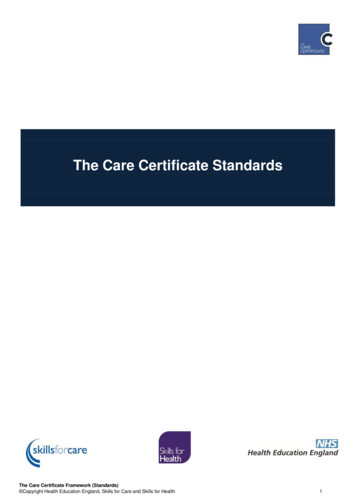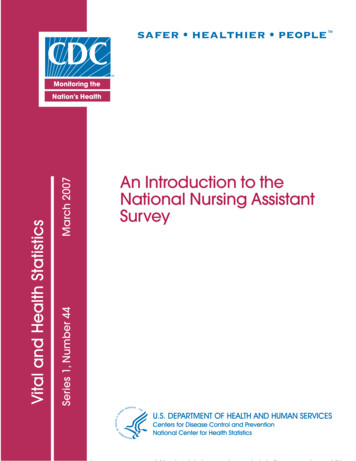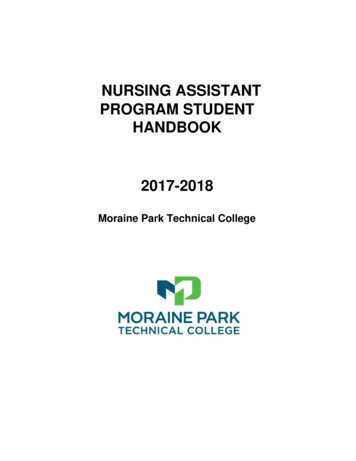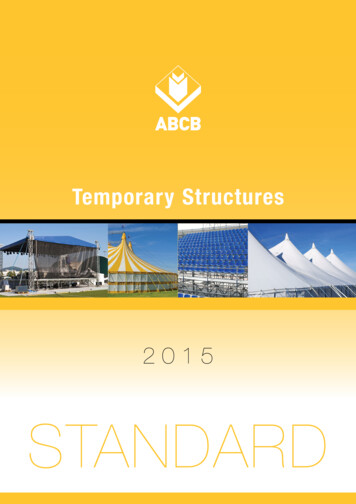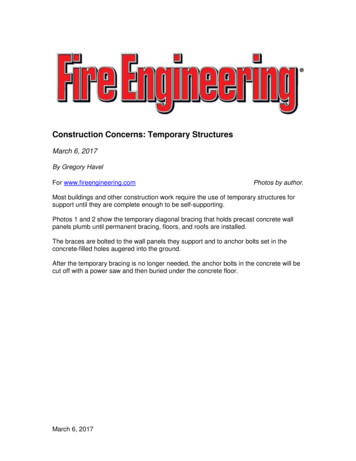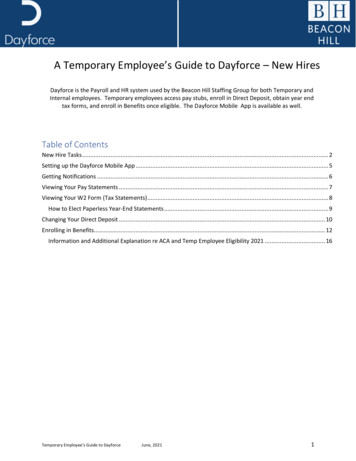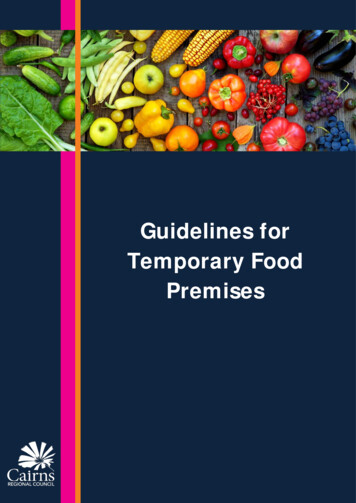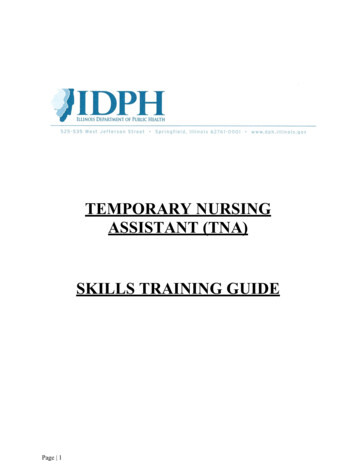
Transcription
TEMPORARY NURSINGASSISTANT (TNA)SKILLS TRAINING GUIDEPage 1
Administration of Competency EvaluationThe Performance Skills are trained and evaluated in the classroom or laboratory setting. Thecompetency checklist is performed on patients/residents where possible once the instructor, whomust be a registered nurse, has determined skills competency in the lab or classroom setting.Resident rights and preferences are to be observed at all times. It is not acceptable to askpatients/residents to leave their room in order to administer the skills portion of the competencyexamination. Visitors may be asked to leave the room but are not required to do so unless thepatient/resident requests them to leave.Each program will determine how many opportunities will be given to students to pass eachperformance skill evaluation, typically three attempts. If a student fails any of the PerformanceSkills after the required number of attempts, the student cannot work as a Temporary NursingAssistant (TNA).Skills competency must be recorded on the checklists enclosed with this guide and retained in theemployee’s training record.Temporary nursing assistants are required to be entered onto the Health Care Worker Registry andfacilities must continue to comply with the Health Care Worker Background Check Act. Instructions forcorrectly entering a TNA on the registry are in a separate document entitled “New Position Type--TNA.”All of the skills listed on the next page are demonstrated at nstructors/performance-skills-videos/ and may be used as introductory material or reviewfor skills testing.Please note that the 8-hours of training at the American Health Care Association website nurse-aide includes more skills than are allowable by thismanual. Only the skills listed on the next page are allowed in Illinois for Temporary NursingAssistants (TNA).The skills are listed below with the performance steps that must be included to show competency.Page 2
Selected Manual Performance SkillsA separate performance skill checklist is provided for each of the following skills: Performance Skill #1Performance Skill #2Performance Skill #3Performance Skill #4Performance Skill #5Performance Skill #6Performance Skill #7Performance Skill #8 Performance Skill #9Performance Skill #10Performance Skill #11Performance Skill #12Performance Skill #13Performance Skill #14 Performance Skill #15Performance Skill #16Performance Skill #17Performance Skill #18Performance Skill #19Wash handsPerform Oral HygieneShave a Resident with an electric razorGive Partial BathGive a Shower or Tub BathMake Occupied BedDress a ResidentTransfer Resident to Wheelchair Using aTransfer/Gait BeltAssist with Transfer Using Mechanical LiftAmbulate with Transfer BeltFeed A ResidentCalculate Intake and OutputPlace Resident in a Side-Lying PositionMeasure and Record Temperature, Pulse andRespirationsMeasure and Record Blood PressureMeasure and Record WeightMeasure and Record HeightDonning and Doffing non-sterile glovesChoking: Heimlich ManeuverSTUDENTS MUST SHOW COMPENTENCY IN ALL OF THE MANDATORYPERFORMANCE SKILLS IN ORDER TO SUCCESSFULLY COMPLETE ATEMPORARY NURSING ASSISTANT TRAINING PROGRAM.Note that use of a mechanical lift, measurement of temperature, pulse, respirations, bloodpressure, height, and weight are not mandatory. These skills are indicated in bold font above.-Page 3-
Beginning and Completion TasksSome skills have beginning and completion tasks. All skills havebeginning tasks.BEGINNING TASKS1.2.3.4.5.6.7.Wash Hands.Assemble Equipment.Knock and pause before entering.Introduce self and verify resident identity as appropriate.Ask visitors to leave.Provide privacy for the resident.Explain the procedure and answer questions.Note: Let the resident assist as much as possible and honor preferences.COMPLETION TASKS1.2.3.4.5.6.7.8.9.10.11.12.Position the resident comfortably.Remove or discard gloves/protective equipment.Wash hands.Return the bed to an appropriate position.Place signal cords, phone and water within reach of the resident.Conduct general safety check/resident and environment.Open the curtains.Care for the equipment as necessary.Wash hands.Allow visitors to reenter, as appropriate.Report completion of task, as appropriate.Document actions and observations.-Page 4-
WASH HANDSSTANDARD: HANDS ARE WASHED WITHOUT RECONTAMINATION.While equipment may vary, the principles noted on the competency exam must befollowed at all times.Directions: Place a “p” for PASSED in the column to the right of each step when it is performedaccording to the standard.1Stood so that clothes did not touch sink.2Turned on water and adjusted temperature; left water running.3Wet wrists and hands; kept hands lower than level of elbowthroughout procedure.4Applied soap or cleaning agent to hands using available products.5Washed hands and wrists using friction for 20 seconds.6Rinsed hands and wrists well under running water with fingertipspointed down.7Dried hands thoroughly with paper towel(s) from fingertips towrists.8Used paper towel between hand and faucet to turn off water.9Disposed of used paper towels.-Page 5-
PERFORM ORAL HYGIENESTANDARD: MOUTH, TEETH AND/OR DENTURES WILL BE FREE OF DEBRIS.Directions: Place a “p” for PASSED in the column to the right of each step when it is performedaccording to the standard.1Performed beginning tasks2Positioned resident.3Cleaned oral cavity using appropriate oral hygiene products.4Rinsed oral cavity.5Repeated steps 3 and 4 until oral cavity was clean.6Cleaned and rinsed teeth, dentures if applicable.7Assisted resident to clean and dry mouth area.8Performed completion tasks-Page 6-
SHAVE A RESIDENT WITH AN ELECTRIC RAZORSTANDARD: RESIDENT IS FREE OF FACIAL HAIR WITH NO ABRASIONS ORLACERATIONS.The student is assigned the task of shaving a resident’s (preferably male) face. Theevaluator must obtain a listof residents who need to be shaved and for whom shaving is not contraindicated.Example: Residents taking anticoagulants should not be assigned.Directions: Place a “p” for PASSED in the column to the right of each step when it is performedaccording to the standard.1Performed beginning tasks2Positioned resident.3Shaved resident: Electric Shave:a. Checked to be sure that the razor was clean.b. Verified that the resident was prepared with a clean, dry face.c. Turned on razor, observing precautions for using electricalequipment.d. Shaved resident by holding skin taut and moving the razorover a small area of the face in the direction of the hair growthuntil the hair was removed.e. Cleaned the razor after use.f. Applied after shave product as appropriate.4Performed completion tasks-Page 7-
GIVE PARTIAL BATHSTANDARD: DESIGNATED BODY AREAS, INCLUDING THE PERINEAL AREA,ARE WASHED, RINSED AND DRIED.Directions: Place a “p” for PASSED in the column to the right of each step when it is performedaccording to the standard.1Performed beginning tasks2Prepared resident for partial bath.3Filled basin with water at correct temperature to residentpreference.4Washed, rinsed and dried face, hands, axilla, perineal area andother areas as appropriate.5Removed linen used for bathing and placed in appropriatecontainer.6Prepared resident for dressing.7Performed completion tasks-Page 8-
GIVE A SHOWER OR TUB BATHSTANDARD: BODY IS CLEAN USING A SHOWER OR TUB BATH.Directions: Place a “p” for PASSED in the column to the right of the step when it is performedaccording to the standard.1Performed beginning tasks2Prepared resident for shower or tub bath.3Adjusted water temperature to resident preference throughout bath.4Washed, rinsed and dried in appropriate head to toe sequenceallowing for resident independence.5Shampooed hair as appropriate.6Prepared resident to leave shower or tub bath area.7Performed completion tasks-Page 9-
MAKING AN OCCUPIED BEDSTANDARD: OCCUPIED BED MUST BE NEAT, WRINKLE FREE WITH PERSONAND BED PLACED IN THE APPROPRIATE POSITIONS.The person must be in bed with the side rails up (if applicable) while the bed is beingmade. If side rails are not available, an alternative safety measure shall be used. Whenside rails are used as a safety measure during this procedure, care must be taken toprevent personal injury.Gloves shall be worn when handling soiled linen.At the completion of this task the bed must be left in the appropriate position with siderails up or down as indicated by the needs of the individual and/or as indicated on thecare plan.Directions: Place a “p” for PASSED in the column to the right of each step when it is performedaccording to the standard.1Performed beginning tasks2Removed top linen, keeping person covered.3Positioned individual on one side of bed with side rail up (ifapplicable) using appropriate safety measures on unprotected sideand using appropriate body mechanics.4Tucked dirty linen under individual. Used gloves if linen iscontaminated with blood or body fluids.5Replaced bottom linen on first side. Tucked corners and sidesneatly under mattress.6Repositioned individual to other side using appropriate safetymeasures on unprotected side.7Removed dirty linen by rolling together, held away from clothing,and placed dirty linen in appropriate container. Disposed of gloves,if used, and washed hands.8Completed tucking clean linen under mattress with corners andsides tucked neatly under mattress on the second side.-Page 10-
9Repositioned the individual to a comfortable position.10Placed top sheet over individual. Removed dirty covering. Tuckedbottom corners and bottom edge of sheet under mattress, asindicated.11Placed blanket/spread over person. Tucked bottom corners andbottom edge or blanket/spread under mattress, as indicated. Pulledtop edge of sheet over top edge of blanket/spread.12Removed and replaced pillowcase appropriately. Replaced pillowunder individual’s head.13Placed bed in appropriate position.14Performed completion tasks-Page 11-
DRESSING A PATIENT/RESIDENTSTANDARD: RESIDENT IS DRESSED IN OWN CLOTHING, INCLUDINGFOOTWEAR, WHICH IS NEAT AND CLEAN. RESIDENT ISCOMFORTABLE DURING DRESSING PROCEDURE AND CHOOSESOWN CLOTHING WHEN ABLE.Clothing should consist of undergarments, dress, or shirt or blouse and pants, socks andfootwear.Directions: Place a “p” for PASSED in the column to the right of each step when it is performedaccording to the standard.1Performed beginning tasks2Asked resident preference and gathered resident’s own cleanclothing.3Dressed the resident in undergarments, top, pants (or dress) andfootwear, as appropriate.4Performed completion tasks-Page 12-
TRANSFER PATIENT/RESIDENT TO WHEELCHAIRWITH TRANSFER/GAIT BELTSTANDARD: APPLIED TRANSFER/GAIT BELT; ASSISTED RESIDENT TOSTAND, PIVOT AND SIT IN WHEELCHAIR WITH BODY ALIGNED.This skill requires that a resident be transferred from the bed to a wheelchair with the useof a transfer/gait belt.Directions: Place a “p” for PASSED in the column to the right of each step when it is performedaccording to the standard.1Performed beginning tasks2Lowered bed to appropriate position.3Positioned wheelchair at bedside.4Locked brakes.5Assisted resident to sitting position.6Applied transfer belt firmly around the resident’s waist (should beadjusted to allow evaluator to place one or two fingers between thebelt and the resident).7Adjusted transfer belt over clothing so that buckle is off center.8Applied non-skid footwear to resident.9Grasped transfer belt on both sides with underhand grasp.10Assisted resident to stand; pivot and sit in wheelchair.11Placed resident’s feet on footrests, if applicable.12Aligned resident’s body in wheelchair.13Performed completion tasks-Page 13-
ASSIST WITH TRANSFER USING AMECHANICAL LIFTSTANDARD: TRANSFERRED PERSON SAFELY UTILIZING A MECHANICALLIFT (This skill is not mandatory).Note: Temporary nursing assistants cannot be the primary operator of a mechanicalLift. A temporary nursing assistant can only assist with a transfer.Followed facility policy for use of lift according to manufacturer’s instructions.Directions: Place a “p” for PASSED in the column to the right of the step when it is performedaccording to the standard.1Performed beginning tasks2Identified appropriate lift for resident.3Applied correct sling/belt.4Attached sling/belt to mechanical lift.5Verified resident’s readiness for transfer.6Operated the mechanical lift controls according to manufacturer’sinstructions.7Maneuvered the lift safely.8Lowered resident safely.9Disconnected sling/belt from lift.10Removed sling/belt if applicable.11Performed completion tasks-Page 14-
AMBULATE WITH TRANSFER/GAIT BELTSTANDARD: AMBULATED PERSON SAFELY UTILIZING TRANSFER BELT.May be tested in the classroom or in the clinical setting.Directions: Place a “p” for PASSED in the column to the right of the step when it is performedaccording to the standard.1Performed beginning tasks.2Locked bed or chair wheels, if appropriate.3Ensured the person was appropriately attired including non-skidfootwear.4Applied transfer belt firmly around person’s waist (should beadjusted to allow evaluator to place two fingers between the beltand the person.)5Assisted the person to standing position.6Stood at the person’s affected side (if applicable) while balance isgained.7Ensured the person stood erect with head up and back straight, astolerated.8Assisted the person to walk. Walked to the side and slightlybehind the person. Held transfer belt using under hand grasp.9Encouraged the person to ambulate normally with the heel strikingthe floor first. Discouraged shuffling or sliding, if noted.10Ambulated the required distance, if tolerated.11Assisted the person to return to bed or chair.12Removed transfer belt appropriately.13Performed completion tasks.-Page 15-
FEED A RESIDENTSTANDARD: RESIDENT IS FED PRESCRIBED DIET IN A COURTEOUS ANDSAFE MANNER.The student should be assigned to feed someone without any special feeding techniquesrequired.Temporary nursing assistants cannot feed patients/residents with swallowing deficits.Directions: Place a “p” for PASSED in the column to the right of each step when it is performedaccording to the standard.1Performed beginning tasks.2Prepared the resident for the meal (i.e. allowed resident to use toiletand wash hands).3Positioned resident in sitting position as appropriate.4Matched food tray/diet items with resident’s diet order.5Matched food tray/dietary items with appropriate resident.6Protected resident’s clothing, as appropriate or as resident prefers.7Noted temperature of food and liquids to avoid food that is too hotor too cold.8Fed moderate-sized bites with appropriate utensil.9Interacted with resident as appropriate (i.e., conversation, coaxing,cueing, being positioned at eye level with the resident).10Alternated liquids with solids, asking resident preference.11Ensured the resident has swallowed food before proceeding.12Cleaned resident as appropriate when completed.13Removed tray, cleaned area.14Performed completion tasks.-Page 16-
CALCULATE INTAKE AND OUTPUTSTANDARD: TOTAL INTAKE AND OUTPUT QUANTITIES CALCULATEDWITHOUT ERROR.The student is to measure intake and output in cubic centimeters (cc) or milliliters (ml).The student may be told the fluid capacity of the containers (glasses, cups, bowls).Directions: Place a “p” for PASSED in the column to the right of each step when it is performedaccording to the standard.1Performed beginning tasks.2Wrote down the intake and output amounts in the units used tomeasure the intake and output quantities (i.e., cc cubic centimeters,ml milliliters, oz ounces).3Converted the measured unit into the units to be recorded onresident intake and output chart.4Calculated all the measured quantities listed as resident intake toobtain a total amount of intake for the time period.5Added all the measured quantities listed as resident output to obtaina total amount of output for the time period.6Recorded the total intake and output to be compared to the recordedintake and output calculation of the evaluator.7Performed completion tasks.-Page 17-
PLACE RESIDENT IN SIDE-LYING POSITIONSTANDARD: BODY ALIGNED WITH DEPENDENT EXTREMITIES SUPPORTEDAND BONY PROMINENCES PROTECTED.Either of two positions is acceptable: side-lying position or a variation in which kneesare flexed with appropriate padding between the knees and ankles.Directions: Place a “p” for PASSED in the column to the right or each step when it is performedaccording to the standard.1Performed beginning tasks.2Raised side rail on unprotected side of bed (if applicable).3Positioned resident on side in the center of the bed in side-lyingposition.4Placed appropriate padding.a. Behind back.b. Under head.c. Between legs.d. Supporting dependent arm.5Ensured resident is in good body alignment.6Raised side rails, if appropriate.7Performed completion tasks.-Page 18-
MEASURE & RECORD TEMPERATURE, PULSE,AND RESPIRATIONSSTANDARD: ORAL TEMPERATURE IS MEASURED TO WITHIN OR – 0.2DEGREES OF EVALUATOR’S READING UNLESS A DIGITAL THERMOMETERIS USED. RADIAL PULSE IS MEASURED TO WITHIN OR – TWO BEATS OFEVALUATOR’S RECORDING OF RATE. RESPIRATON IS MEASURED TOWITHIN OR – TWO RESPIRATIONS OF EVALUATOR’S RECORDING OFRATE. (This skill is not mandatory)The evaluator must simultaneously count the rate for the length of time specified by thestudent and determine the correct rate.Pulse and Respiration cannot be a combined procedure; they must be measuredseparately.Directions: Place a “p” for PASSED in the column to the right of the step when it is performedaccording to the standard.MEASURE ORAL TEMPERATURE:1Performed beginning tasks.2Positioned resident, sitting or lying down.3Activated the thermometer.4Covered thermometer as appropriate.5Placed the thermometer probe appropriately.6Instructed the resident to close mouth around the thermometer.7Stayed with the resident during the entire procedure.8Removed the thermometer when appropriate.9Read the thermometer.10Recorded and reported the results within or – 0.2 degrees of theevaluator’s recorded temperature reading.11Performed completion tasks.-Page 19-
MEASURE RADIAL PULSE:1Performed beginning tasks.2Positioned resident, sitting or lying down.3Located radial pulse at wrist.4Placed fingers over radial artery. Student does this first, thenevaluator locates pulse on opposite wrist.5Determined whether to count for 30 seconds or 60 seconds.6Counted pulsations for 30 seconds and multiplied the count by 2;or for one minute if irregular beat. Student must tell when to startand end count.7Recorded the pulse rate within or – two beats per minute of pulserate recorded by evaluator.MEASURE RESPIRATION:8Positioned hand on wrist as if taking the pulse as appropriate.9Determined whether to count for 30 seconds or 60 seconds.10Counted respirations for 30 seconds and multiplied the count by 2;or for one minute if irregular. Student must tell when to start andend count.11Recorded the respiratory rate within or – two respirations perminute of respiratory rate recorded by evaluator.12Performed completion tasks.-Page 20-
MEASURE BLOOD PRESSURESTANDARD: MEASURE AND RECORD BLOOD PRESSURE TO WITHIN OR –4MM OF THE EVALUATOR’S READING USING STETHOSCOPE(This skill is not mandatory)A teaching/training (dual head design) stethoscope may be used simultaneously by thestudent and the evaluator. In the event that a student is hearing impaired, that studentwill be allowed to use an amplified stethoscope. If facility policy allows automaticblood pressure measuring, the student should be trained per the facility policy.Directions: Place a “p” for PASSED in the column to the right of each step when it is performedaccording to the standard.1Performed beginning tasks.2Cleaned earpieces of stethoscope.3Positioned resident sitting or lying.4Made sure the room was quiet; turned down loud TV or radio.5Selected the appropriate size cuff and applied it directly over theskin, above the elbow.6Positioned the stethoscope over the brachial artery.7Inflated the cuff per the instructor’s direction.8Identified the systolic and diastolic measurements while deflatingthe cuff.9Deflated the cuff in a timely manner.10Re-measured, if necessary, to determine the accuracy (waited oneminute if using the same arm or use the other arm, if appropriate).11Recorded blood pressure measurement to be compared with theblood pressure recorded by the evaluator.12Performed completion tasks.-Page 21-
MEASURE AND RECORD WEIGHTSTANDARD: MEASURE AND RECORD WEIGHT TO WITHIN OR – ½ POUND.(This skill is not mandatory)Directions: Place a “p” for PASSED in the column to the right of each step when it is performedaccording to the standard.1Performed beginning tasks.2Balanced scale at zero.3Weighed individual.A. Individual who is able to stand to be weighed:a. Placed paper towel on scale platform.b. Assisted individual to stand on scale platform withoutfootwear.c. Read weight measurement.d. Recorded weight measurement to be compared to the weightmeasurement recorded by the evaluator.e. Assisted individual off of scale with appropriate assistance asnecessary.ORB. Individual who is weighed by wheelchair or bed scale:a. Sanitized wheelchair/bed scale according to facility policy.b. Assisted individual on wheelchair scale or bed scale asappropriate.c. Read weight measurement.d. Recorded weight measurement to be compared to the weightmeasurement recorded by the evaluator.e. Assisted resident off wheelchair/bed scale as appropriate.4Returned scale balanced to zero.5Performed completion tasks.-Page 22-
MEASURE AND RECORD HEIGHTSTANDARD: HEIGHT IS MEASURED TO WITHIN ½ INCH IN EITHERSTANDING OR NON-STANDING INDIVIDUAL (This skill is not mandatory)Directions: Place a “p” for PASSED in the column to the right of each step when it is performedaccording to the standard.1Performed beginning tasks.2Measured height.A. Individuals who are ABLE TO STAND:a. Used appropriate measuring device.b. Placed paper towel on platform as appropriate.c. Instructed individual to stand erect without shoes.d. Read height measurement.e. Recorded height measurement and converted appropriatelyto be compared to the height measurement recorded by theevaluator.ORB. Individuals who are UNABLE TO STAND:a. Position individual on side or back without shoes.b. Used appropriate measuring device.c. Read height measurement.d. Recorded height measurement and converted appropriatelyto be compared with the height measurement recorded bythe evaluator.e. Repositioned individual, as necessary.3Performed completion tasks-Page 23-
DONNING AND DOFFING NON-STERILEEXAMINATION GLOVESSTANDARD: GLOVES ARE APPLIED AND REMOVED WITHOUTCONTAMINATION.1Perform hand washing/sanitizing.2Selected correct type and size of glove. Remove glove frombox/container.3Touch only the cuff edge of the glove when possible.4Don the first glove.5Remove the second glove from the box/container.6Don the second glove without touching the arm.7Does not touch any surface/person not defined by theindications for use.812Remove gloves by pinching one glove at the wrist level to remove itwithout touching the skin of the forearm.Peel glove away from the hand allowing the glove to turn inside out.Continue to hold the removed glove in the gloved hand.Slide the fingers of the ungloved hand between the glove and thewrist.Remove second glove by rolling it down the hand and folding overthe first glove.Discard the removed gloves.13Perform handwashing/sanitizing.91011-Page 24-
HEIMLICH MANEUVERSTANDARD: STUDENT WILL PERFORM STEPS OF THEHEIMLICH MANEUVER CORRECTLY.12Patient/resident exhibits signs of choking. Student identifies needfor abdominal thrusts.Get person to stand up if able.3Student positions self behind choking person.4Student places arms around choking person’s waist5Student makes fist and places it thumb side in just above theumbilicus (navel)Student grabs fist with the other hand and pushes it inward andupward at the same time. Student performs five abdominal thrusts.6789If choking person cannot stand, student straddles the waist facingthe person and pushes fist inward and upward in the same manner asif standing.Student repeats thrusts until object is expelled or person becomesunconscious.If person becomes unconscious, begin CPR if qualified.-Page 25-
Temporary Nursing Assistant (TNA) Skills CompetencyTNA Name:Date of completion: / /Skills training exceptions (any of the non-mandatory skills in which the TNA was not trained):Evaluator (trainer) name and credentials:Evaluator (trainer) signature:-Page 26-
Skills after the required number of attempts, the student cannot work as a Temporary Nursing Assistant (TNA). Skills competency must be recorded on the checklists enclosed with this guide and retained in the employee's training record. Temporary nursing assistants are required to be entered onto the Health Care Worker Registry and
